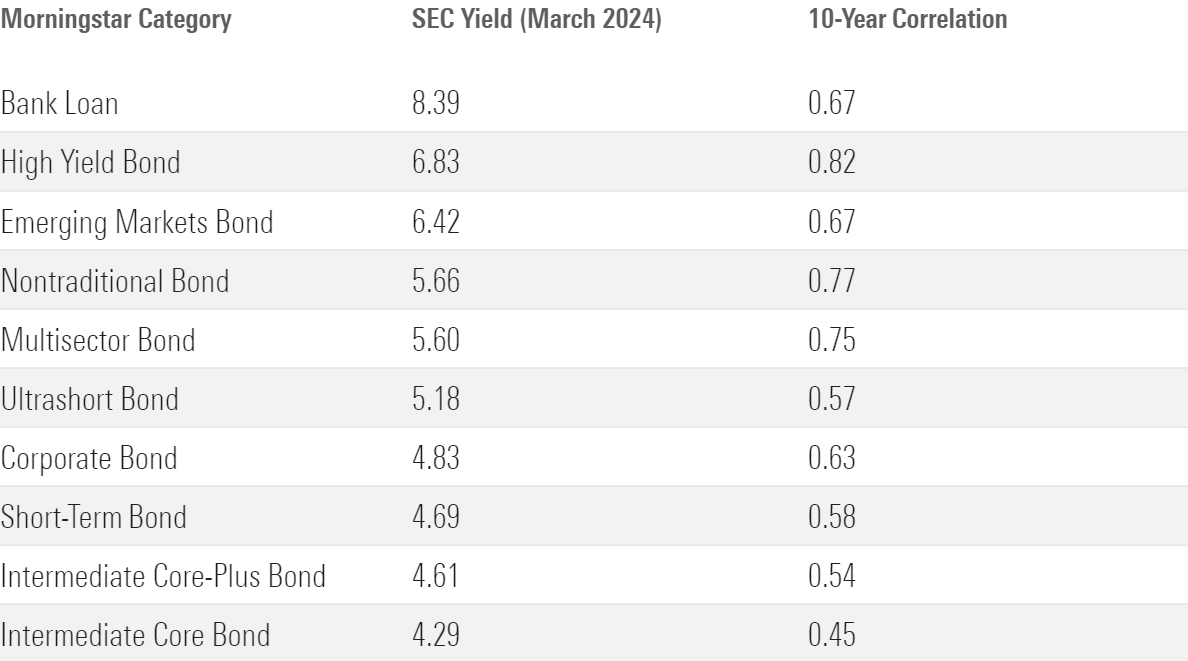Bond Investors Have New Options for High Yields
The ‘income’ is back in fixed income. Where should investors start?

While recent interest-rate increases tank bond prices, they also create juicier starting yields, increasing expected prospective returns. That sounds like a good thing, but where should investors start?
Options abound for those looking to branch outside of traditional core bond allocations. Three such specialty allocations are bank loans, high-yield bonds, and corporate bonds. Funds in these categories can complement a diversified portfolio, but it’s important to remain cognizant of their unique purposes and risks.
As has been the case across all fixed income, yields in these categories have shot up in recent years.
SEC Yields by Category
Bank Loans
Most bank loans are rated below investment-grade, but they offer decent yields and protection against rising rates. The asset class’ credit risk and inherent illiquidity were apparent in the depths of the coronavirus panic from Feb. 20, 2020, to March 23, 2020, when the average loan fund lost 19.7%. That was in line with the average high-yield bond fund’s 20.0% loss and among the harshest across fixed-income categories. But loans shone as the Federal Reserve hiked rates from 2022-23; the average bank-loan fund’s 2.6% loss in 2022 was much less than the average corporate-bond fund’s 15.2% loss, owing to the latter’s greater rate sensitivity.
Fidelity Floating Rate High Income’s FFRHX scale and research depth make it among the category’s most compelling options. At over $13 billion, it is by far the category’s largest strategy, and it also has strong relationships with private equity sponsors that give it access to harder-to-source deals. The fund yielded 8.7% as of March 2024, as measured by SEC yield, which estimates the average current yield of all bonds within a given fund’s portfolio.
High-Yield Bond
High-yield bond funds had the highest correlation with equities of any fixed-income Morningstar Category over the trailing 10 years through April 2024. While that spelled trouble during 2020′s covid selloff, the category bounced back better than bank loans on its way to posting a 4.8% gain for that year, middle-of-the-pack relative to other fixed-income categories. With a shorter-than-average duration, funds in this category can offer some meaningful protection from rate changes. The average high-yield bond fund’s 11.8% return in 2023 trailed only bank loans as the best in fixed income.
PGIM High Yield’s PBHAX breadth and depth of leveraged finance research set it apart from competitors. The strategy benefits from the firm’s ample resources, too, including an impressive proprietary risk-management system that closely monitors tracking-error budgets. That helps make returns relatively predictable for the fundamental-focused strategy that eschews equities, convertibles, and non-US currencies. The fund yielded 7.3% as of March 2024.
Corporate Bond
While corporate-bond funds are correlated with equities, they tend to take on less credit risk and more interest-rate risk than their respective bank-loan and high-yield bond fund counterparts. Indeed, the category average’s 12.5% loss from Feb. 20, 2020, to March 23, 2020, was more than 7 percentage points less than the bank-loan and high-yield bond category averages. But its average effective duration is typically around 7.0 years, more than twice that of the average high-yield bond fund. That contributed to corporate bond-funds lagging high-yield bond funds in the first quarters of 2021 and 2022 by about 5 and 3 percentage points, respectively.
Pimco Investment Grade Credit Bond’s PIGIX strong leadership and resourcefulness continue to make it one of the category’s best funds. The strategy’s more recent track record isn’t as strong as its longer-term one, but that doesn’t diminish the approach’s appeal. Lead manager Mark Kiesel and company regularly explore out-of-index sectors, such as high-yield, corporate, emerging-markets debt, and securitized fare, to add value. The group’s strong credit-picking capabilities make it a good bet to outperform over the long term. The fund yielded 5.2% as of March 2024.
Stress-Period Returns
Tread Carefully
While all three of the above categories are typically among the highest-yielding in the asset class, they are also more strongly correlated to equities. The latter point is especially important given that investors often use fixed income as a ballast and volatility damper in portfolios. Be sure to look beyond gaudy yields, and carefully weigh each category’s unique risk/return trade-offs.
Yields and Correlations by Category

This article first appeared in the April 2024 issue of Morningstar FundInvestor. Download a complimentary copy of FundInvestor by visiting this website.
The author or authors do not own shares in any securities mentioned in this article. Find out about Morningstar’s editorial policies.

/s3.amazonaws.com/arc-authors/morningstar/f490381f-5450-44be-b474-313f03204bfb.jpg)
/d10o6nnig0wrdw.cloudfront.net/06-11-2024/t_a4a9c8e4b4944a9fab91f0fccfde5dcc_name_MIC_24_Jerome_Schneider_Speaker_1920x1080.png)
/cloudfront-us-east-1.images.arcpublishing.com/morningstar/AGAGH4NDF5FCRKXQANXPYS6TBQ.png)
/cloudfront-us-east-1.images.arcpublishing.com/morningstar/OMVK3XQEVFDRHGPHSQPIBDENQE.jpg)
:quality(80)/s3.amazonaws.com/arc-authors/morningstar/f490381f-5450-44be-b474-313f03204bfb.jpg)